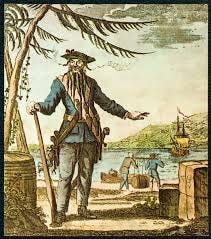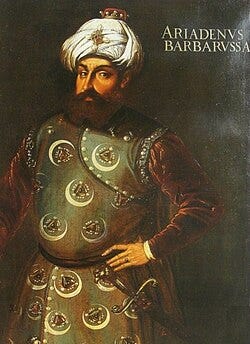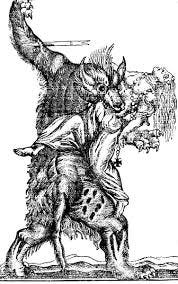“Where there are boats, there are pirates.” Said somebody at some point.
Pirates have been around a long time. I wrote a very brief bit about pirates a while back (see here https://chrisobo.substack.com/p/piracy?utm_source=publication-search). This will be a bit more in depth.
As mentioned in the aforementioned blog, (I deliberately wrote that sentence that way to give Barb a headache when she edits it) Piracy has been around since the 14th century BCE and probably existed before that. Humans have a long history of taking stuff that isn’t theirs, so I suspect piracy started with boats.
The word pirate comes from ancient Greek peîra, “attempt”. The word pirate first appeared in English in the early fourteenth century. Piracy in the relatively recent past centered around the Mediterranean, the Caribbean and the China Seas/Southeast Asia.
Letters of Marque
There have been a lot of famous pirates over the centuries and whether someone was a pirate or not often depended on the country and the letter of marque.
A Letter of Marque and Reprisal was given by governments to private captains and allowed them to attack the ships of another country the government was at war with, thus making the private captains mercenaries. This allowed a government to continue a war without expending much in the way of funds, men, or equipment.
If the English and French are at war, the English government may issue a letter of marque to a ship’s captain allowing him to attack French ships. Once a ship and or cargo were captured, the privateer was to go to a friendly port and appear before an admiralty court who would rule on whether the marque was valid and recognized . If so, the cargo and ship were put to auction with the proceeds going to the privateer captain, his or her crew, and the government. I say her since there were female privateers.
The first letter of Marque was issued in 1243 by Henry II of England.
Letters of marque gave legitimacy to pirate activities and numerous false letters were used to attempt to justify pirate action.
Some Famous Pirates
Beards – Black, Blue and Red.
Blackbeard
One of the most famous pirates was Edward Teach, 1680 (or so) – 1718. He was known as Blackbeard for his scraggly beard, which was, surprise, black. In a very short career, he developed a fearsome reputation. Little is known of his early life but sometime around 1716 he joined the crew of a West Indies pirate, Benjamin Hornigold, where he was given command of a sloop. Near the end of 1717, Hornigold retired (interesting story I’ll tell in the future) and Teach, with two ships continued his pirate ways, eventually capturing a 40 gun French Merchantman who he renamed The Queen Anne’s Revenge.
Over the next year, Blackbeard captured at least 25 ships, held the port of Charles Town, South Carolina ransom, accepted a pardon for piracy, settled down, returned to piracy and was eventually killed November 21, 1718 by English pirate hunters.
Blackbeard became the archetype for the pirate of fiction. Known to prefer intimidation over violence, he was not the prototypical pirate.
Redbeard
Hayreddin Barbarossa (1478-1546), also known as Redbeard, was a Turkish pirate, later admiral in the Ottoman Empire. Born on the island of Lesbos, he joined his brothers in privateering against the Knights Hospitaller (Knights of St. John) who were themselves privateering against the Ottomans.
A succession dispute in the Ottoman empire caused Barbarossa to flee to the Western Mediterranean where he and his brothers defended North Africa from Spanish aggression while at the same time raiding Spanish ports. Eventually Barbarossa made a deal with the Ottoman sultan, was appointed Pasha of Algiers, and eventually captured the Knights Hospitaller base on the island of Rhodes.
He spent much of the next decade sending his ships to raid ports in Sicily, Sardinia and he was eventually promoted to Admiral of the Ottoman Navy. He spent the rest of his life making life difficult for the Spaniards, so much so they tried to bribe him into changing sides. He refused. Retiring to Istanbul in 1545, he died in 1546 after dictating his memoirs.
Redbeard was his nickname since he had a red beard (people in those times seemed to be very literal when assigning nicknames).
BlueBeard
Didn’t exist. He’s a fictional character from 17th century CE French folklore. A man who has a habit of murdering his wives and was in turn killed by his seventh wife in self defence. He is thought to be based on the 6th century CE, Breton king, Conomor the Accursed (again with the obvious nicknames), who beheaded his wife, St. Tryohine. His wife was then miraculously restored to life by St. Gildas and Conomor was killed when his wife returned to their home and caused the castle walls to collapse. (The really weird part of this story is that it is claimed that Conomor killed all his previous wives when they became pregnant. I’m thinking he was unclear on the whole heir to the throne, keep the dynasty running idea. Also speaking of weird, local folklore said Conomor was a werewolf. I mean maybe he really was accursed.)
Next time Southeast Asian and Chinese pirates.
Cheerio




